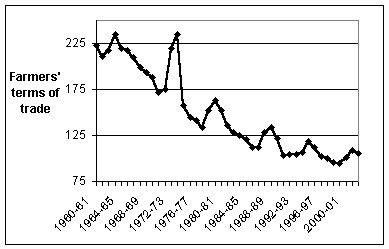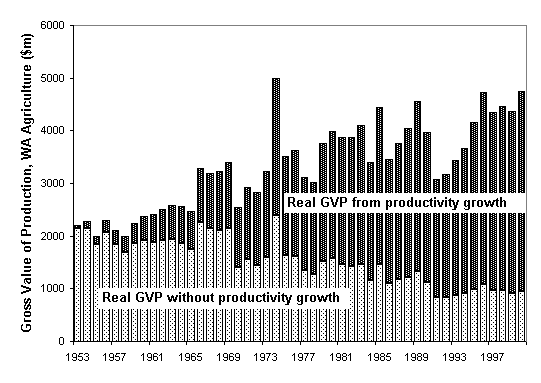60 – Agricultural productivity growth
If you are trying to swim up a flowing river, you have to swim faster than the current. Farmers face a similar problem in trying to stay profitable in the face of steadily falling real prices for their outputs. To stay afloat they have to increase their productivity year by year.
Figure 1 shows the extent to which Australian farmers have faced a fall in the ratio of their output prices to input costs over the past 40 years: the so called “cost-price squeeze”.
Figure 1: Farmers’ terms of trade. Base year 1997-8 = 100. (Source: ABARE)
Swimming against that current means that farmers must steadily increase their productivity. Broadacre farmers in Western Australia have experienced particularly high levels of productivity growth in grain production compared with producers from many other regions, with average productivity growth of 3.5 per cent per annum, over the 21 years up to 1998-1999 (Ha and Chapman, 2000). By contrast sheep specialist, beef specialist and sheep-beef specialist farms recorded productivity annual productivity growth of only 0.6, 2.1 and 1.4 per cent over the same period.
Improvements in productivity may arise through technological advances, improvements in management and through exploiting economies of size. R&D figures prominently as a contributor to these productivity improvements. Major technical advances in Australian agriculture in the last two decades have included the following:
- There has been an increasing array of herbicides, reducing the need for tillage, and improved spray technologies supporting the earlier sowing of crops.
- New crop and pasture options and varieties have become available over the past three decades.
- Improvements in farm machinery for tillage, spraying and harvest have increased the ease and efficiency of many farm operations. Farmers have invested in larger machinery with work rates that offer economies of size and have markedly increased their capacity to store grain on farm.
- Improved communications (fax, mobile phone, internet) and computer technology have increased the speed and range of information received by farmers.
- A greater variety of sheep breeds (Awassi, Damara, Dorper) are now grown and are preferred to merinos in some markets.
The crucial role that increasing productivity plays in the economic viability of agriculture is starkly illustrated in Figure 2. It shows that productivity growth in Western Australian agriculture has more than offset falls in real prices since 1953. Accumulated productivity improvements since 1953 now constitute most of the gross value of production for agriculture.
Figure 2: Gross value of agricultural production (GVP) in Western Australia, showing that portion due to accumulated productivity improvement. (Source: John Mullen, pers. comm., 2004, based on Mullen, 2002).
David Pannell, The University of Western Australia
Further Reading
Ha, A., and L. Chapman (2000) Productivity growth trends across Australian broadacre industries. Australian Commodities 7, no. 2: 334-240.
Kingwell, R.S. and Pannell, D.J. (2005). Economic trends and drivers affecting the grainbelt of Western Australia to 2030, Australian Journal of Agricultural Research 56(6): 553-561. full paper (82K) Published version (126K pdf file)
Mullen, J. (2002) Farm management in the 21st Century, Agribusiness Review 10: paper 5. Available here.

